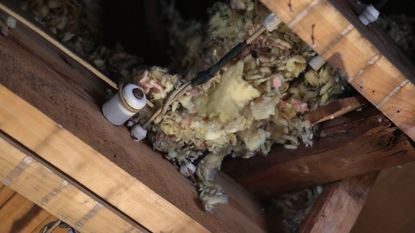Many homes built before the 1980s contain asbestos. The natural mineral was used in a whole host of products and materials found in a home as different as roof shingles and cement, tile and fuse boxes.
But the fact that it’s natural certainly doesn’t mean asbestos can’t present dangers. Exposure to its fibers could cause mesothelioma and other cancers, plus a host of other diseases. Carrying out home improvement projects, like updating a ceiling design, can run the risk of exposure, and there’s also a danger of exposure to asbestos if a product or material becomes damaged or starts to deteriorate.
But where exactly might you find it in your home, what does asbestos look like, and what should you do about it? Use our expert guide to get savvy.
Asbestos in the home
Asbestos was widely used in the past because of its properties. The fibers are strong and flexible, it offers low thermal conductivity, and it resists fire, among other attributes.
It is generally found in older homes and if you live in a home built after the 1980s it is less likely to contain asbestos. Be aware, though, that the materials that contain it may have still been used into the 1990s.
It’s breathing in air that contains asbestos fibers or swallowing them by consuming food or liquids that have become contaminated that can cause health problems, so it’s important to be aware of the signs it’s in your home to prevent exposure.
What does asbestos look like?
Unfortunately, it’s very difficult to identify asbestos just by looking and samples need to be sent to a lab to be tested. Moreover, there are actually different types of asbestos, and they don’t look the same as one another. ‘It varies in size, shape, color, and appearance,’ explains Hailee Claycomb of Mesothelioma.com, which provides information on mesothelioma and spreads awareness on the dangers of asbestos exposure.
‘Asbestos is made up of thousands of microscopic fibers undetectable by the naked eye,’ she adds. ‘Patches of asbestos can be white, blue, or brown with either curly, soft fibers or hard, needle-like fibers.’
Chrysotile, or white asbestos, is the most common type. ‘It’s often found in places where heat protection may be a factor including roofing, insulation, cement, asphalt and old boilers,’ says Simon Walter, director and lead consultant at Rhino Safety. ‘It can also be present in rubber, plastics and some textiles.’
Crocidolite, or blue asbestos, meanwhile was widely used for insulation. ‘As a result, it may be found surrounding pipes or even as a component in spray-on coatings,’ says Simon. ‘It can also be found in old cement and tiles.’
Other types of asbestos include amosite (brown asbestos), tremolite, actinolite, and anthophyllite.
Where could asbestos be present in a home?
As asbestos varies in its appearance, what’s therefore important is to know in which products and areas of a home it might occur. These are the places where it could be present.
Exterior: roofing, siding, window putty
Insulation: vermiculite and batt
Interior decor: popcorn ceilings and other textured ceilings, ceiling tile, textured paint, joint compound
Flooring: tile, around woodburning stoves
Electrical equipment: fuse boxes, outlets, wiring insulation, recessed lighting
Boilers and heating: duct coverings and linings, gaskets, seals, around pipes, furnaces, boiler insulation
Drywall from before the 1980s
Popcorn ceiling was very popular from the mid 20th century to its end, so if you decide to remove popcorn ceiling, there is the potential to be exposed to asbestos. Other places you might encounter it are on the roof, in the attic, in crawl spaces, via hot water pipe insulation, walls, and in old floor tile.
The bottom line? If asbestos is present in your home, renovation projects along with maintenance tasks could expose you to it, as could its deterioration or if damage occurs. Flood and fire or a natural disaster could also cause exposure.
What should you do if you suspect there’s asbestos in your home?
If you live in an older home, don’t panic. ‘Asbestos rarely poses a threat when it is enclosed and hidden,’ says Hailee Claycomb.
Do be aware of it when you are about to embark on a project. ‘If you are doing a renovation or doing remodeling to an older home, you should use caution as you are purposefully disturbing the material,’ says process safety engineer Kevin Bazazzadeh, owner of Brilliant Day Homes. ‘The asbestos fibers will not only be in the air for you to breathe during your work but can also get on your clothes where you could inhale them later.’
Before you begin, check for asbestos. ‘The inspection should be done by a professional,’ says Tomas Satas, founder and CEO at Windy City HomeBuyer.
Although there are home test kits available, we recommend this approach even before tasks such as removal of a popcorn ceiling. If you do take your own sample, always wear an N95 respirator and eye protection.
If you suspect a material in your home is made from asbestos and it’s deteriorating or damaged, it’s also important to call in a trained and accredited professional straight away. Keep everyone away from the area until the pro has visited.
What should you do if you find asbestos when remodeling?
It’s possible that you might start home improvement work and then come across what you suspect is asbestos. ‘The first thing to do is not to panic,’ says Simon Walter. ‘While asbestos can be dangerous, the best thing to do is to deal with it as quickly and safely as possible to reduce risk.
‘Stop work immediately,’ he continues. ‘It’s important to stop work to make sure the material remains as undisturbed as possible. If you think you’ve found some, put your tools down and clear the area. You can easily disturb asbestos by drilling, hammering, replacing ceiling tiles, removing old insulation, or other common home renovation projects.’
Hailee Claycomb emphasizes: ‘It’s highly critical that you don’t move, touch, or dispose of these products. Instead, you should hire an asbestos abatement professional to handle removal. You can contact a local company in your area, but make sure they have the necessary credentials to safely work with asbestos. It’s also crucial to note that asbestos cannot be thrown away in your garbage or dumpster. There are specific packaging and labeling requirements for disposing of asbestos.’



